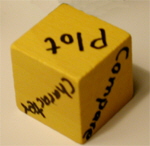|
The narration cube turns narrating into a fun family game. It also breaks down narrating into
Instructions: Family members, including mother, take turns rolling the die and telling about that aspect of the story. If a term is rolled that someone already discussed, the person rolling may tell some new
information not mentioned by the first person or he/she may roll the die again to discuss a different term. There are no right or wrong answers--we each see things uniquely.
PLOT: This is what most children naturally narrate. It is the story line. What happened in the story? SETTING: The setting is the place where the story took place. The time period is part of the
setting that is sometimes overlooked. CHARACTER: Tell about one of the characters. (If this is roll again, the person could tell about one of the other characters.)
COMPARE: This is really compare and contrast. So you could compare and contrast the story to something else that you read, or to your life. Or you could compare and contrast characters
within the story, or compare and contrast characters in this story to those in another story. There are many possibilities here that allow the child to connect the story with something else.
How is it the same and how is it different? THEME: What do you think the author’s main point is? Or what is the moral of the story? For
example, the theme of Cinderella might be “Good people may have a hard life but in the end they will be rewarded.” The term “theme” might be the most difficult for children to grasp.
Again, there is more than one correct answer. A good place to practice figuring out themes is to read
THE HEART: This is where you have an opportunity to share your favorite part of the story or a part that evoked some emotion in you (perhaps sadness or the part you didn’t like). This is very open-ended. Karen Rackliffe, developer of the narration cube says: “The CM principle involved is that she
wanted all the children to be prepared to narrate about the book in the classroom but children do have a tendency to go on and on. By rolling the dice, they only need tell a portion instead
of the more daunting task of narrating everything. If you are using it in a group the best points are covered by different individuals. It also helps the children be more specific. (Plot is
storyline or main conflict and resolution. Setting is where the story takes place. Character can be favorite character or villain or how a character changes and grows from the experience.
Theme is the moral of the story or the main point the author is trying to illustrate. Compare stands for "compare and contrast" where the child can compare the story to another, or to their
own life, or contrast characters or philosophies. The heart is for your favorite part of the story, favorite character, favorite episode (or least favorite), how it made you feel....
In keeping with CM philosophy there are no wrong answers but you may need to model a few times what you are looking for by taking a turn yourself. Great for family read-alouds or co-ops.
Also good practice for essay questions that generally focus on one statement instead of a whole narration.” Make a narration cube for your family using a wooden cube or make a cube out of card stock. There is a pattern available at http://atozteacherstuff.com/pdf.htm?cube_outline.pdf. This low- or no-cost little item will put some fun into orally narrating. Return to Language arts. CM Approach to Education. Return to home page . CM philosopy. |
||








 smaller chunks so it is not overwhelming. By using the cube, your children are also learning about common literary terms.
smaller chunks so it is not overwhelming. By using the cube, your children are also learning about common literary terms.